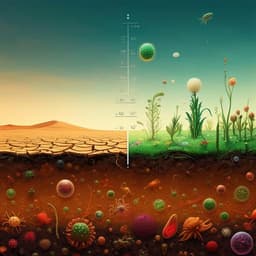Introduction
Earth's soils store vast amounts of carbon in soil organic matter (SOM), exceeding the combined carbon storage of global vegetation and atmosphere. The fate of this substantial terrestrial carbon reservoir under global change remains uncertain, hindering accurate prediction of carbon cycle-climate feedbacks. While topsoil carbon (SOC) dynamics have been extensively studied, a significant portion (approximately half) of the global SOC stock resides in deeper soil layers (subsoil). Deep SOC formation originates from various processes including the percolation of dissolved organic matter and organo-mineral particles, organic matter inputs from deep plant roots, accumulation of eroded soil, and bioturbation by soil fauna. Globally, soil depth is a primary driver of SOC dynamics, with turnover times increasing from decades/centuries in topsoil to millennia in subsoil. However, the mechanisms underlying these slow subsoil dynamics remain controversial. Understanding these mechanisms is crucial for both enhancing our fundamental understanding of SOC dynamics and improving our ability to predict how this vast carbon reservoir will respond to global change.
Previous research has often attributed the persistence of deep SOC to stabilization mechanisms that limit microbial decomposer access. These mechanisms include mineral protection, where SOC is physically associated with reactive minerals, and physical separation, where the sparse distribution of SOC leads to spatial heterogeneity within the soil matrix. Suboptimal environmental conditions such as low temperatures and anaerobic conditions have also been proposed, though their importance in well-aerated mineral soils remains debated. A more recent hypothesis suggests that the high persistence of deep SOC may be related to a fundamental energy limitation of decomposers at depth. Theoretical models suggest that microbes decomposing persistent SOC are primarily limited by the energy required for the biosynthesis of exoenzymes. A key concept here is the 'return-on-energy-investment', where the energy gained from metabolizing SOC must exceed the energy invested in exoenzyme production for decomposition to occur. Negative returns or insufficient energy for maintenance lead to microbial starvation and the persistence of SOC. A bioenergetic framework has been proposed to assess SOC energy quality based on this return-on-energy-investment principle. Studies have shown that deep SOC has lower energy density and greater thermal stability compared to surface SOC, suggesting reduced energy quality with depth.
The energy limitation hypothesis also provides a mechanistic explanation for the destabilization of deep SOC through fresh organic matter supply. Plant roots, through rhizodeposition, supply fresh, energy-rich substrates, potentially triggering the decomposition of low-energy-quality, persistent SOC via microbial co-metabolism. Rhizosphere priming, the stimulation of SOC decomposition by root exudates, can thus alleviate energy limitations. However, direct experimental evidence linking deep SOC dynamics to its bioenergetic signature and response to rhizosphere priming has been lacking. This study aims to address this gap by investigating the bioenergetic control of depth-dependent SOC dynamics in temperate, well-aerated mineral soils.
Literature Review
The high persistence of deep soil organic carbon (SOC) has been a subject of extensive research, with several hypotheses proposed to explain the phenomenon. Early explanations focused on stabilization mechanisms, including mineral protection and physical separation of SOC from microbial decomposers. Mineral protection involves the tight association of SOC with reactive minerals, rendering it less accessible to microbial enzymes. Physical separation highlights the spatial heterogeneity of SOC within the soil matrix, leading to reduced encounter rates between SOC and decomposers. These mechanisms limit the accessibility of SOC to microbial degradation, resulting in its slow turnover. In addition to these physical and chemical limitations, environmental factors such as low temperatures and anaerobic conditions in deep soil layers have also been suggested as significant factors influencing SOC persistence. These suboptimal conditions can directly inhibit microbial activity, further slowing down decomposition rates.
More recently, a bioenergetic framework has emerged as a promising alternative explanation. This framework emphasizes the role of energy limitation in regulating SOC decomposition. The core principle revolves around the 'return-on-energy-investment' (ROI) for microbial decomposers. Microbes invest energy in producing exoenzymes that break down SOC. If the energy gained from metabolizing the resulting products is less than the energy spent on enzyme production, the decomposition process becomes energetically unfavorable, leading to SOC persistence. This concept has been supported by studies demonstrating the lower energy density and higher thermal stability of deep SOC compared to topsoil SOC, suggesting a decline in energy quality with depth. Furthermore, studies have shown that the addition of fresh organic matter, often associated with root exudates, can stimulate the decomposition of older, more recalcitrant SOC through a process known as rhizosphere priming, suggesting that energy availability is a critical factor governing SOC dynamics.
Methodology
To investigate the bioenergetic control of depth-dependent SOC dynamics, the researchers employed a multi-faceted approach. They selected three soil types—a cambisol, a vertisol, and an andosol—representing a range of mineral reactivity contexts. Soil cores were collected from both topsoil and subsoil layers of each soil profile. A detailed biogeochemical characterization of these samples was conducted, focusing on several key properties:
* **Soil Carbon Properties:** SOC concentration, radiocarbon signature (Δ¹⁴C), particulate organic matter (POM) and mineral-associated organic matter (MAOM) fractions, δ¹³C signature, and microbial biomass.
* **Thermal Analyses:** Differential scanning calorimetry (DSC) to determine SOC energy density (ΔE), Rock-Eval pyrolysis and oxidation to assess activation energy (Ea) and thermal stability (T₉₀-HxCy-pyrolysis, T₅₀-CO₂-pyrolysis, T₅₀-CO₂-oxidation), Hydrogen Index (HI), and Oxygen Index (OI).
* **Soil Mineralogy:** Soil pH, clay content, phyllosilicate mineralogy (XRD), cation exchange capacity (CEC), major exchangeable cations, and concentrations of reactive metals (Fe, Al, Si).
* **Root Density:** Root dry mass was measured to assess root density in topsoil and subsoil.
The SOC turnover time was estimated from Δ¹⁴C measurements using a one-pool model. A bioenergetic framework was applied, defining SOC energy quality as the return-on-energy-investment (ROI), calculated as the ratio of energy density (ΔE) to mean activation energy (µEa). Long-term soil incubations were conducted under controlled conditions, with and without continuously ¹³C/¹⁴C-labelled plants (*Dactylis glomerata*) to investigate rhizosphere priming effects. These incubations involved regularly measuring respiration of the plant-soil system and analyzing CO₂ isotopic composition (¹³C, ¹⁴C) to partition CO₂ sources and assess the mean age of native SOC respired. The experiment was designed to decouple the natural covariation between root density and SOC properties by growing plants in soil columns made exclusively of topsoil or subsoil. Statistical analyses were used to assess the relationships between SOC dynamics, bioenergetic parameters, root density, and soil mineralogy. Specific statistical tests applied are detailed in the supplementary methods.
Key Findings
The study revealed a clear differentiation of SOM properties across soil depth, consistently observed across all three soil types despite their contrasting mineralogy. Subsoil, compared to topsoil, exhibited:
* Lower SOC concentration and radiocarbon signature (Δ¹⁴C), indicating older carbon pools.
* Higher δ¹³C signature, suggesting greater microbial processing.
* Higher proportion of MAOM and lower proportion of POM.
* Reduced microbial biomass.
* Significantly longer SOC turnover time (on average, a 6.9-fold increase from 1096 to 7567 years).
Bioenergetic analysis showed a substantial shift in SOC's bioenergetic signature with depth:
* Subsoil SOC had 27.6% lower energy density (ΔE) compared to topsoil.
* Subsoil SOC had a higher mean activation energy (µEa) of decomposition, indicating higher energy barriers.
* The ROI parameter (ΔE/µEa), representing SOC energy quality, declined by 28.7% in subsoil.
* Root density declined dramatically with depth (95.6% reduction).
Soil incubations revealed that:
* In the absence of roots, the native SOC decomposition rate (kSOC) was 3.0-fold smaller in subsoil compared to topsoil.
* The presence of roots significantly accelerated kSOC, demonstrating a rhizosphere priming effect (RPE). The magnitude of RPE was significantly higher for subsoil than topsoil.
* The RPE was positively correlated with the respiration of plant-derived OC and living root density.
* At high plant activity or root density, kSOC values for topsoil and subsoil converged, highlighting the potential for root activity to overcome the energy limitations in subsoil. Radiocarbon analysis of respired CO₂ in unplanted subsoil cores indicated that decomposition involved millennia-old carbon pools.
Despite differences in mineralogy, all three soil types displayed a consistent pattern of slower SOC dynamics with depth linked to both reduced SOC energy quality and root density. The high mineral reactivity of the andosol and vertisol was associated with a greater sensitivity to rhizosphere priming, indicating that while minerals provide protection, they also make SOC more susceptible to root-induced destabilization when suitable energy subsidies are available.
Discussion
The findings strongly support the hypothesis that bioenergetic constraints of decomposers are the primary drivers of the depth-dependency of SOC dynamics, irrespective of mineral reactivity. The slow turnover of subsoil SOC is a consequence of its poor energy quality, characterized by low energy density and high activation energy. This unfavorable ROI for decomposers leads to limited microbial activity and SOC persistence. The low root density in subsoil exacerbates this energy limitation, further contributing to SOC stability. Rhizosphere priming, as demonstrated by the experiments, effectively overcomes these limitations by providing an influx of fresh, energy-rich substrates from root exudates, thereby subsidizing the energy costs of decomposition and enabling the utilization of previously recalcitrant SOC. This stimulation is far more profound in subsoil, where the energy limitation is most acute. The results challenge previous notions that strong mineral protection alone explains SOC persistence and highlight the interactive effects of both energy quality and accessibility. The results suggest that mineral protection mechanisms can be interpreted within a bioenergetic framework, where the energy costs associated with overcoming these limitations play a crucial role.
The observed strong mineral control on the sensitivity of SOC to rhizosphere priming, where increased mineral reactivity led to a stronger RPE, suggests that root exudates can disrupt organo-mineral associations, making SOC more accessible to decomposition. The controlled incubation experiments rule out the influence of abiotic factors such as temperature and oxygen limitations as primary causes for the observed slowing of SOC dynamics with depth. In well-aerated soils, the bioenergetic constraint of microbial metabolism appears to be a dominant factor.
Conclusion
This study provides compelling evidence for the bioenergetic control of soil carbon dynamics across depth. The persistence of deep SOC is primarily determined by its poor energy quality and the limited energy supply from sparse root systems. Rhizosphere priming, driven by root activity and exudates, can significantly accelerate the decomposition of this persistent carbon, highlighting the interactive nature of energy limitation and SOC accessibility. Future research should focus on quantifying the net effect of increased plant rooting depth, a potential consequence of global change, on deep SOC storage, considering the balance between stimulated decomposition and potential enhanced SOC formation. The findings raise concerns about relying solely on deep-rooting plant species as a carbon sequestration strategy.
Limitations
While the study provides strong evidence for the bioenergetic control of SOC dynamics, several limitations should be acknowledged. The experimental design, focusing on three specific soil types, may limit the generalizability of the findings to other soil environments with different characteristics. The use of a single plant species for the incubation experiments could influence the results. The one-pool model used to estimate SOC turnover time simplifies the complex dynamics of carbon cycling in soils. Finally, while the study focuses on well-aerated soils, the role of energy limitation in other soil environments, particularly those with anaerobic conditions, requires further investigation.
Related Publications
Explore these studies to deepen your understanding of the subject.







